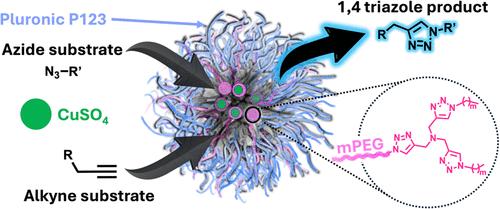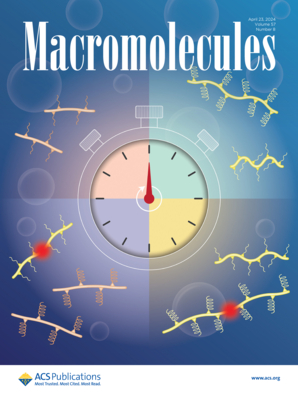胶束 "点击 "纳米反应器:给基于 Pluronic 的微胶囊添加聚合物配体
IF 5.2
1区 化学
Q1 POLYMER SCIENCE
引用次数: 0
摘要
近年来,由于纳米反应器(如用于催化转化的胶束纳米反应器(MNR))在提高反应速率、选择性和效率方面的潜力,以及更重要的是在水溶液中进行有机化学反应的能力,其发展受到了广泛关注。其中,铜(I)催化的叠氮-炔环加成反应(CuAAC)是一种关键的转化反应,被广泛应用于生物共轭物、药物和先进材料的合成。本研究旨在促进我们对设计和利用含有三-三唑配体的聚合物双亲化合物的理解,将其作为在 MNRs 中进行 CuAAC 反应的一个不可或缺的元素。具体来说,我们的研究深入探讨了影响 MNR 内反应速率的三个关键因素:疏水性、聚合物配体的结构配置及其浓度。利用树枝状双亲化合物的高分子精度,我们合成了具有两种不同结构的聚合物配体,即 PEG-二三三唑双亲化合物(DTA)和 PEG-单三唑双亲化合物(MTA),并通过与市售的 Pluronic P123 双亲化合物共组装探索了它们的 CuAAC 反应活性。结果表明,在影响反应速率方面,聚合物配体的结构和浓度比树枝状嵌段的疏水性起更主要的作用。值得注意的是,虽然仅由 DTA 组装的 MNR 显示出较低的反应速率,但在 P123 胶束中添加 DTA 得到的 MNR 的反应速率明显更快。此外,与添加了 DTA 的 P123 MNR 相比,添加了合成的 MTA 的 P123 MNR 显示出更高的 CuAAC 反应速率,其性能甚至优于广泛使用的三(苄基三唑甲基)胺配体。这些发现对聚合物配体的设计原理提供了宝贵的启示,有助于构建活性 MNR 和其他类型的纳米反应器,实现高效催化转化。本文章由计算机程序翻译,如有差异,请以英文原文为准。

Micellar “Click” Nanoreactors: Spiking Pluronic-Based Micelles with Polymeric Ligands
In recent years, the development of nanoreactors, such as micellar nanoreactors (MNRs) for catalytic transformations, has gained significant attention due to their potential in enhancing reaction rates, selectivity, efficiency, and, as importantly, the ability to conduct organic chemistry in aqueous solutions. Among these, the copper(I)-catalyzed azide–alkyne cycloaddition (CuAAC) reaction represents a pivotal transformation and is widely used in the synthesis of bioconjugates, pharmaceuticals, and advanced materials. This study aims toward advancing our understanding of the design and utilization of polymeric amphiphiles containing tris-triazole ligands as an integral element for CuAAC reactions within MNRs. Specifically, our investigation delves into three critical factors that influence the reaction rate within MNRs: hydrophobicity, architectural configuration of the polymeric ligands, and their concentration. Utilizing the high molecular precision of dendritic amphiphiles, we synthesized polymeric ligands with two distinct architectures, namely, PEG-ditris-triazole amphiphile (DTA) and PEG-monotris-triazole amphiphile (MTA), and explored their CuAAC reactivity through coassembly with commercially available Pluronic P123 amphiphiles. The results indicate that the architecture and the concentration of the polymeric ligands play more dominant roles in influencing the reaction rate than the hydrophobicity of the dendritic blocks. Notably, while MNRs assembled from solely DTA showed a dampened reaction rate, spiking P123 micelles with DTA yielded an MNR with significantly faster rates. Moreover, P123 MNRs spiked with the synthesized MTA demonstrated increased CuAAC reaction rates compared to those spiked with the DTA, and they even outperformed the widely used Tris(benzyltriazolylmethyl)amine ligand. These findings provide valuable insights into the design principles of polymer-based ligands for constructing reactive MNRs and other types of nanoreactors for efficient catalytic transformations.
求助全文
通过发布文献求助,成功后即可免费获取论文全文。
去求助
来源期刊

Macromolecules
工程技术-高分子科学
CiteScore
9.30
自引率
16.40%
发文量
942
审稿时长
2 months
期刊介绍:
Macromolecules publishes original, fundamental, and impactful research on all aspects of polymer science. Topics of interest include synthesis (e.g., controlled polymerizations, polymerization catalysis, post polymerization modification, new monomer structures and polymer architectures, and polymerization mechanisms/kinetics analysis); phase behavior, thermodynamics, dynamic, and ordering/disordering phenomena (e.g., self-assembly, gelation, crystallization, solution/melt/solid-state characteristics); structure and properties (e.g., mechanical and rheological properties, surface/interfacial characteristics, electronic and transport properties); new state of the art characterization (e.g., spectroscopy, scattering, microscopy, rheology), simulation (e.g., Monte Carlo, molecular dynamics, multi-scale/coarse-grained modeling), and theoretical methods. Renewable/sustainable polymers, polymer networks, responsive polymers, electro-, magneto- and opto-active macromolecules, inorganic polymers, charge-transporting polymers (ion-containing, semiconducting, and conducting), nanostructured polymers, and polymer composites are also of interest. Typical papers published in Macromolecules showcase important and innovative concepts, experimental methods/observations, and theoretical/computational approaches that demonstrate a fundamental advance in the understanding of polymers.
 求助内容:
求助内容: 应助结果提醒方式:
应助结果提醒方式:


